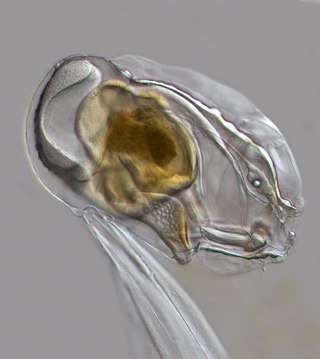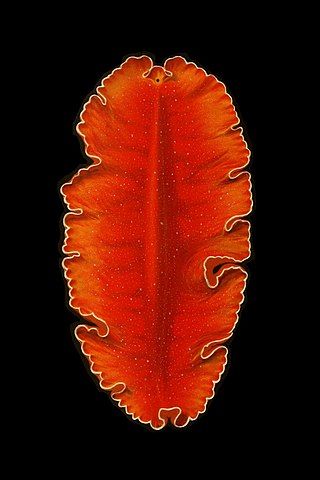
Filter feeders are aquatic animals that acquire nutrients by feeding on organic matters, food particles or smaller organisms suspended in water, typically by having the water pass over or through a specialized filtering organ that sieves out and/or traps solids. Filter feeders can play an important role in condensing biomass and removing excess nutrients from the local waterbody, and are therefore considered water-cleaning ecosystem engineers. They are also important in bioaccumulation and, as a result, as indicator organisms.

A tunicate is an exclusively marine invertebrate animal, a member of the subphylum Tunicata. This grouping is part of the Chordata, a phylum which includes all animals with dorsal nerve cords and notochords. The subphylum was at one time called Urochordata, and the term urochordates is still sometimes used for these animals. They are the only chordates that have lost their myomeric segmentation, with the possible exception of the seriation of the gill slits. However, doliolids still display segmentation of the muscle bands.

Larvaceans or appendicularians, class Appendicularia, are solitary, free-swimming tunicates found throughout the world's oceans. While larvaceans are filter feeders like most other tunicates, they keep their tadpole-like shape as adults, with the notochord running through the tail. They can be found in the pelagic zone, specifically in the photic zone, or sometimes deeper. They are transparent planktonic animals, usually ranging from 2 mm (0.079 in) to 8 mm (0.31 in) in body length including the tail, although giant larvaceans can reach up to 10 cm (3.9 in) in length.

Ascidiacea, commonly known as the ascidians or sea squirts, is a paraphyletic class in the subphylum Tunicata of sac-like marine invertebrate filter feeders. Ascidians are characterized by a tough outer "tunic" made of a polysaccharide.

The Clitellata are a class of annelid worms, characterized by having a clitellum – the 'collar' that forms a reproductive cocoon during part of their life cycles. The clitellates comprise around 8,000 species. Unlike the class of Polychaeta, they do not have parapodia and their heads are less developed.

Oikopleura is a genus of tunicates in the class Appendicularia (larvaceans). It forms a mucus house every four hours at 20 degrees Celsius. This house has a coarse mesh to keep out big particles, and a fine mesh that collects the small particles, down to the nanoplankton that includes (pelagic) bacteria.

The rock beauty, also known as corn sugar, coshubba, rock beasty, catalineta, and yellow nanny, is a species of marine ray-finned fish, a marine angelfish belonging to the family Pomacanthidae. It is found in the western Atlantic Ocean.

Lingula is a genus of brachiopods within the class Lingulata. Lingula or forms very close in appearance have existed possibly since the Cambrian. Like its relatives, it has two unadorned organo-phosphatic valves and a long fleshy stalk. Lingula lives in burrows in barren sandy coastal seafloor and feeds by filtering detritus from the water. It can be detected by a short row of three openings through which it takes in water (sides) and expels it again (middle).

The queen parrotfish is a species of marine ray-finned fish, a parrotfish, in the family Scaridae. It is found on reefs in the tropical West Atlantic Ocean and the Caribbean Sea. Other common names include blownose, blue chub, blue parrotfish, blueman, joblin crow parrot, moontail, okra peji and slimy head. The young males and adult female queen parrotfish are a reddish-brown color, and quite different in appearance from the bluish-green color of the final phase male. This is a common species throughout its range and the International Union for Conservation of Nature has rated its conservation status as "least concern".

Clavelina picta, common name the painted tunicate, is a species of tunicate, in the genus Clavelina. These animals, like all ascidians, are sessile filter feeders.

Ecteinascidia turbinata, commonly known as the mangrove tunicate, is a species of tunicate in the family Perophoridae. It was described to science in 1880 by William Abbott Herdman. The cancer drug trabectedin can be isolated from this species.

Ciona savignyi is a marine animal sometimes known as the Pacific transparent sea squirt or solitary sea squirt. It is a species of tunicates in the family Cionidae. It is found in shallow waters around Japan and has spread to the west coast of North America where it is regarded as an invasive species.
Perophora viridis, the honeysuckle tunicate, is a species of colonial sea squirt in the genus Perophora found in the tropical western Atlantic Ocean.

Oikopleura dioica is a species of small pelagic tunicate found in the surface waters of most of the world's oceans. It is used as a model organism in research into developmental biology.

Astronesthes niger, commonly known as snaggletooth, is a species of small, deep sea fish in the family Stomiidae. It occurs in the tropical and subtropical Atlantic Ocean, the Caribbean Sea and the Gulf of Mexico, as well as the Indian Ocean and western Pacific Ocean, at depths to 1,000 m (3,300 ft).

Urechis caupo is a species of spoon worm in the family Urechidae, commonly known as the innkeeper echiuran, the fat innkeeper worm, the innkeeper worm, or the penis fish. It is found in shallow water on the west coast of North America, between southern Oregon and Baja California, where it forms a U-shaped burrow in the sediment and feeds on plankton using a mucus net.

Paraleptopentacta elongata is a species of sea cucumber in the family Cucumariidae. It is found in the northeastern Atlantic Ocean and parts of the Mediterranean Sea. It is an infaunal species, occupying a burrow in the seabed, from which its anterior and posterior ends project.

Holothuria hilla is a species of sea cucumber in the subgenus Mertensiothuria of the genus Holothuria. Some common names include the contractile sea cucumber, the sand sifting sea cucumber and the tigertail sea cucumber, and in Hawaii it is known as the light spotted sea cucumber. It is found in the Indo-Pacific region and the Red Sea.

Holothuria (Roweothuria) poli, also known as the white spot cucumber, is a species of sea cucumber in the family Holothuridae and the subgenus Roweothuria. The species was first described by the Italian doctor and naturalist Stefano delle Chiaje in 1824. The species' range has been documented as being in the Mediterranean Sea, Red Sea, and the Bay of Biscay.

Yungia aurantiaca is a species of flatworm in the family Pseudocerotidae. It is found in the temperate northeastern Atlantic Ocean and the Mediterranean Sea.


















